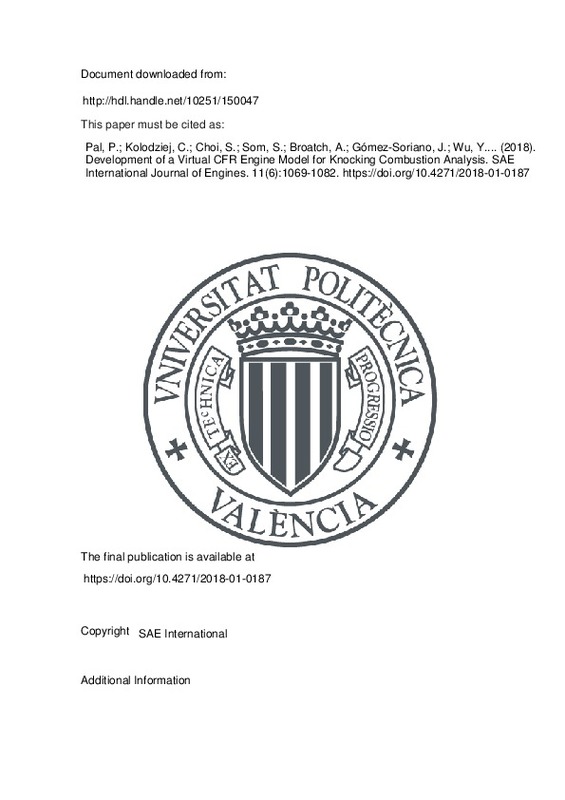JavaScript is disabled for your browser. Some features of this site may not work without it.
Buscar en RiuNet
Listar
Mi cuenta
Estadísticas
Ayuda RiuNet
Admin. UPV
Development of a Virtual CFR Engine Model for Knocking Combustion Analysis
Mostrar el registro sencillo del ítem
Ficheros en el ítem
| dc.contributor.author | Pal, Pinaki
|
es_ES |
| dc.contributor.author | Kolodziej, Christopher
|
es_ES |
| dc.contributor.author | Choi, Seungmok
|
es_ES |
| dc.contributor.author | Som, Sibendu
|
es_ES |
| dc.contributor.author | Broatch, A.
|
es_ES |
| dc.contributor.author | Gómez-Soriano, Josep
|
es_ES |
| dc.contributor.author | Wu, Yunchao
|
es_ES |
| dc.contributor.author | Lu, Tianfeng
|
es_ES |
| dc.contributor.author | See, Yee Chee
|
es_ES |
| dc.date.accessioned | 2020-09-15T03:32:32Z | |
| dc.date.available | 2020-09-15T03:32:32Z | |
| dc.date.issued | 2018 | es_ES |
| dc.identifier.issn | 1946-3944 | es_ES |
| dc.identifier.uri | http://hdl.handle.net/10251/150047 | |
| dc.description.abstract | [EN] Knock is a major bottleneck to achieving higher thermal efficiency in spark-ignited (SI) engines. The overall tendency to knock is highly dependent on fuel anti-knock quality as well as engine operating conditions. It is, therefore, critical to gain a better understanding of fuel-engine interactions in order to develop robust knock mitigation strategies. In the present work, a numerical model based on three-dimensional (3-D) computational fluid dynamics (CFD) was developed to capture knock in a Cooperative Fuel Research (CFR) engine. For combustion modeling, a hybrid approach incorporating the G-equation model to track turbulent flame propagation, and a homogeneous reactor multi-zone model to predict end-gas auto-ignition ahead of the flame front and post-flame oxidation in the burned zone, was employed. In addition, a novel methodology was implemented wherein a laminar flame speed lookup table generated a priori from a chemical kinetic mechanism could be used to provide flame speed as an input to the G-equation model, instead of using conventional empirical correlations. Multi-cycle Reynolds-Averaged Navier Stokes (RANS) simulations were performed for two different spark timings (STs) corresponding to non-knocking and knocking conditions, with other operating conditions kept the same as those of a standard Research Octane Number (RON) test. Iso-octane was considered as the fuel for the numerical study. Two different reduced kinetic mechanisms were employed to describe end-gas auto-ignition chemistry and to generate the flame speed lookup table. Experimental data, including intake/exhaust boundary conditions, was provided by a spark timing sweep study conducted in an in-house CFR engine. Moreover, cylinder wall/valve/port surface temperatures and residual gas fraction (RGF) were estimated using a well-calibrated one-dimensional (1-D) model. On the other hand, a novel methodology was also developed to analyze experimental data for the knocking case and identify the most representative cycle. For the non-knocking case, a good agreement was found between experiment and CFD simulation, with respect to cycle-averaged values of 10% burn point (CA10), 50% burn point (CA50) and peak pressure magnitude/location. The virtual CFR engine model was also demonstrated to be capable of predicting average knock characteristics for the knocking case, such as knock point, knock intensity and energy of resonance, with good accuracy. | es_ES |
| dc.description.sponsorship | The submitted manuscript has been created by UChicago Argonne, LLC, Operator of Argonne National Laboratory (Argonne). Argonne, a U.S. Department of Energy (DOE) Office of Science laboratory, is operated under Contract No. DEAC02-06CH11357. The U.S. Government retains for itself, and others acting on its behalf, a paid-up nonexclusive, irrevocable worldwide license in the said article to reproduce, prepare derivative works, distribute copies to the public, and perform publicly and display publicly, by or on behalf of the Government. This research was partially funded by DOE's Office of Vehicle Technologies and Office of Energy Efficiency and Renewable Energy (EERE) under Contract No. DE-AC02-06CH11357. The authors wish to thank Gurpreet Singh, Kevin Stork, and Leo Breton, program managers at DOE, for their support. This research was conducted as part of the Co-Optimization of Fuels and Engines (Co-Optima) project sponsored by the U.S. DOE Office of EERE, Bioenergy Technologies and Vehicle Technologies Offices | es_ES |
| dc.language | Inglés | es_ES |
| dc.publisher | SAE International | es_ES |
| dc.relation.ispartof | SAE International Journal of Engines | es_ES |
| dc.rights | Reserva de todos los derechos | es_ES |
| dc.subject | Knock | es_ES |
| dc.subject | CFR engine | es_ES |
| dc.subject | G-equation | es_ES |
| dc.subject | Multi-zone | es_ES |
| dc.subject | Research octane number | es_ES |
| dc.subject | Numerical modeling | es_ES |
| dc.subject | Computational fluid dynamics | es_ES |
| dc.subject | Simulation | es_ES |
| dc.subject.classification | MAQUINAS Y MOTORES TERMICOS | es_ES |
| dc.title | Development of a Virtual CFR Engine Model for Knocking Combustion Analysis | es_ES |
| dc.type | Artículo | es_ES |
| dc.identifier.doi | 10.4271/2018-01-0187 | es_ES |
| dc.relation.projectID | info:eu-repo/grantAgreement/DOE//DEAC02-06CH11357/ | es_ES |
| dc.rights.accessRights | Abierto | es_ES |
| dc.contributor.affiliation | Universitat Politècnica de València. Departamento de Máquinas y Motores Térmicos - Departament de Màquines i Motors Tèrmics | es_ES |
| dc.description.bibliographicCitation | Pal, P.; Kolodziej, C.; Choi, S.; Som, S.; Broatch, A.; Gómez-Soriano, J.; Wu, Y.... (2018). Development of a Virtual CFR Engine Model for Knocking Combustion Analysis. SAE International Journal of Engines. 11(6):1069-1082. https://doi.org/10.4271/2018-01-0187 | es_ES |
| dc.description.accrualMethod | S | es_ES |
| dc.relation.publisherversion | https://doi.org/10.4271/2018-01-0187 | es_ES |
| dc.description.upvformatpinicio | 1069 | es_ES |
| dc.description.upvformatpfin | 1082 | es_ES |
| dc.type.version | info:eu-repo/semantics/publishedVersion | es_ES |
| dc.description.volume | 11 | es_ES |
| dc.description.issue | 6 | es_ES |
| dc.relation.pasarela | S\383357 | es_ES |
| dc.contributor.funder | U.S. Department of Energy | es_ES |







![[Cerrado]](/themes/UPV/images/candado.png)

